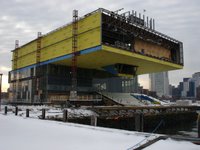AS CONTEMPORARY ARCHITECTURE RETREATS to its postcritical refuge and, as a discipline, increasingly refuses to engage any progressive purpose whatsoever, it is ironic that the opportunities for such engagement are growing in number. From terrorist attacks to tsunamis to hurricanes to earthquakes, there are countless causes and debates to which architects could potentially contribute. Yet, as is most often the case, our profession (along with the rest of society) follows up an initial altruistic fervor with long-term ignorance.
Right now, the reconstruction efforts in the Gulf states happen to be on my mind, probably because as I read more and more about the situation (for example,
this piece by Mike Davis), I keep getting the feeling (some would call it paranoia) that bad things are afoot down south. As mentioned in the previous post, the doctrine of
New Urbanism has somehow become the default in any discussion of rebuilding. Some would ascribe this apparent coup by Andres Duany & Co. as a result of their seemingly innocuous taste for walkable cities, mixed-use development, white picket fences, and colored pencil renderings. I, however, see this movement more as a threat than a remedy: a highly coordinated campaign to refashion the coast of Mississippi and Louisiana into a suburban, Disneyfied, and (most importantly) Republican-voting region. (For precedents, see
Seaside and
Celebration.)
Much has already been said about the New Urbanist agenda, and I must say that many of its basic ideas certainly are sound, particularly seen in their context as a reaction against the devastating modernist escapades of postwar urban planning. It's hard to find somebody who will argue against the merits of being able to walk to work, have access to mass transportation, etc., etc. Nevertheless, an architect or planner (or anyone, for that matter) must be aware of the consequences of his or her ideology, however unpredicted or unintended. The early avant-garde iconoclasm of Mr. Duany and his friends does not excuse their having since morphed into developer-friendly producers of insta-suburbs. The entire movement is founded on a lie: they are in the business of promoting a culture of false nostalgia for a past that never existed in the first place. For me, the fact that the ideology of New Urbanism was chosen directly by Mississippi's governor
Haley Barbour (a Republican fat cat and former head of the Republican National Committee, among
other things) is no coincidence. The ideological symmetry of New Urbanism and contemporary conservative politics is undeniable. For now, it seems that Biloxi, Gulfport, and the rest of the Mississippi coastline has fallen under the New Urbanist spell, but the larger issue is the one that nobody is talking about: as the New Urbanists set their sights futher west to Louisiana, what are the implications for New Orleans? The city is the bluest oasis in a deep red state
— but perhaps not for long, if some people have their way. After all, why redistrict when you can just "reconstruct"?
I realize I should contextualize my ire: This is all part of a larger dissatisfaction with the profession's current fixation with pragmatism and aversion to any broader progressive mission. Maybe the post-critics can take their own advice and pragmatically recognize that here and now, in what will be perhaps the largest reconstruction efforts in the history of this country, there are myriad opportunities for architects to do what they do best without playing into the hands of a reactionary regime.
Obviously I could go on and on. And indeed I will. But in the meantime, here are some of the latest responses/criticisms/thoughts on the topic of Katrina's New Urbanism:
- Why not start with a fan of New Urbanism, like this blogger, who claims (in a grammatical tour-de-force worthy of our prez-dint) that "What we need is suburbs, farms and living, thriving cities, not one or the other."
- Blogger Nancy Levinson has some interesting (and refreshingly optimistic) comments on the "disaster after the disaster." Includes her initial misgivings about New Urbanism as well as a follow-up piece on the need to broaden the reconstruction discussion beyond style to larger issues of urban and ecological infrastructure.
- By far the most direct, enjoyable, and all-around best piece I've read recently on post-Katrina: Mike Davis's piece "Gentrifying Disaster" from Mother Jones. If you read nothing else, read this. Good enough for me to cite twice in one post.
- Christopher Hawthorne's piece in the LA Times that clarifies what exactly is at stake. Hawthorne explicitly makes the parallel between the New Urbanists and their right-wing patrons:
"The Biloxi charrette, in other words, may go down as the architectural elite's Ohio: the place it watched rather helplessly as its ideological opponents outclassed it notthrough nimble thinking or grand theory or inspiring plans but simply by being more disciplined and better organized."








